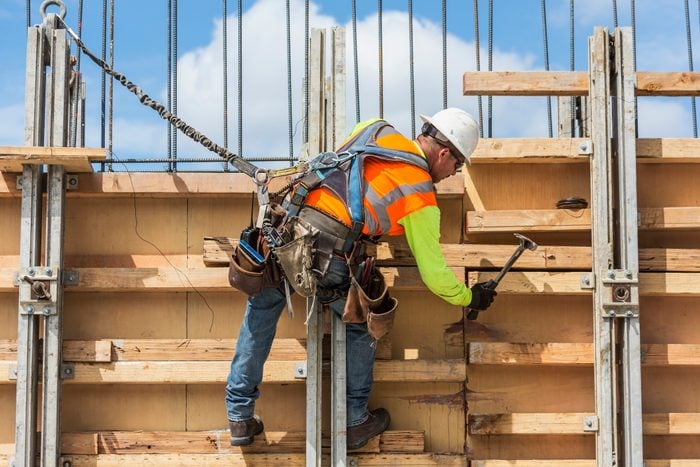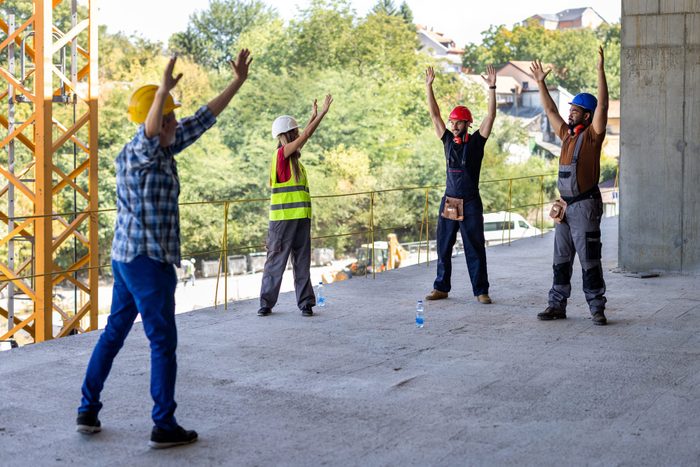
The Important Stretches
A full day of construction work is hard on the body. That’s why workers should adopt a full-body stretching routine. This can take 10 to 15 minutes and focus on the neck, back, legs, core, chest and arms.
Here are some of the most important stretches for construction workers:
-
Neck stretches:
-
Slowly rotate the chin from shoulder to shoulder, holding for a few seconds at each shoulder. Repeat five times.
-
Touch your chin to your chest, then slowly tilt your head backward. Repeat five times.
-
Roll head clockwise five times and then counterclockwise five times.
-
-
Leg stretches:
-
Stand straight, bend your knee and lift one foot behind you. Hold the foot with the hand on the same side. Hold it for 10 seconds. Swap legs. Repeat three times.
-
Keep legs straight, bend forward and attempt to touch your toes. Hold for 10 seconds. Repeat three times.
-
-
Shoulder stretches:
-
Place hands at your sides. Roll shoulders upward, backward, downward, and forward. Do five circles in each direction.
-
Tuck your chin so your ears are in line with your shoulders. With one arm behind the back, try to pull the shoulder blade down. Hold for 10 to 15 seconds before swapping. Repeat two times.
-
-
Chest stretches:
-
Make a W shape with your hands and arms. Squeeze the shoulder blades together. Hold for five seconds. Repeat five times.
-
Open up your arms and stand with palms facing forward. Reach your arms backward and hold the stretch for 10 to 15 seconds. Repeat two or three times.
-
-
Core stretches:
-
Lay flat on your stomach. Place your hands, palms down, under your shoulders. Press up from the ground, keeping hips in contact with the floor. Hold for 15 to 30 seconds.
-
Sit in a chair with your back straight. Cross arms over your chest, hands on shoulders. Rotate to the left, tense core muscles, then release after five to 10 seconds. Repeat on the other side.
-
-
Arm stretches:
-
Lift both arms overhead, then bend one elbow. With the other hand, grasp the bent elbow and gently push it behind. Hold for 20 seconds before switching. Repeat on both sides at least twice.
-
Cross one arm across your body. With the other arm, reach up and pull the elbow joint across further to stretch. Hold for 20 seconds and repeat two to three times.
-
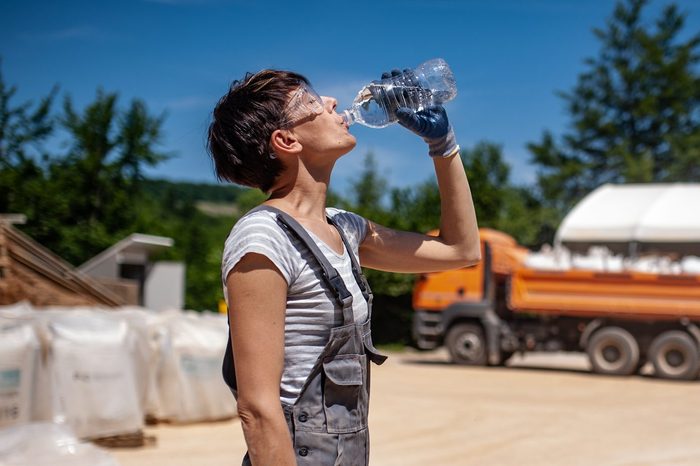
Hydration is Everything
Drinking plenty of water throughout the day is incredibly important. Water helps you perform at your best, maintain focus and avoid injuries. It’s so vital the Occupational Safety and Health Administration (OSHA) requires construction companies to provide potable water and allow workers to drink it at will.
What’s the suggested daily water intake? Most experts believe the ideal amount to be between eight and 13 cups a day. Construction workers may require more, especially in hotter conditions.

Before Working a Full Day
Important stretches: All the ones mentioned above.
Most construction workers can go through the entire range of their motion before they even start work.
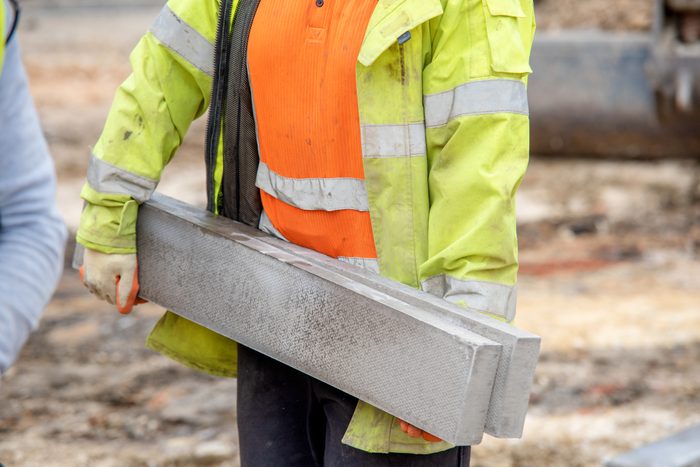
Before Carrying a Heavy Load
Important stretches: Legs, neck, back and arms.
Most heavy lifting should always be done with the legs, but the core, neck and arms are involved as well. Stretch all these muscles to prepare them for the load.
Concentrate on the legs, neck and back, particularly the lower back, which can become rounded while lifting and lead to injury. When lifting, be sure to keep your back in a neutral position and let your legs do the work.
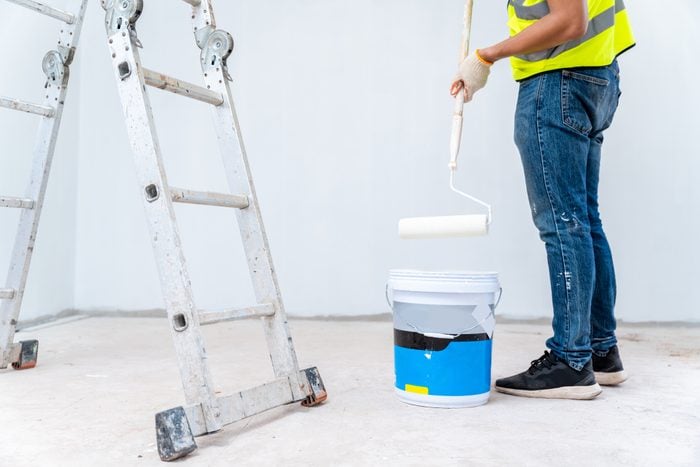
Before Painting a Room
Important stretches: Neck, shoulders and back.
Painting might not be the most arduous work out there, but it can still be a workout, particularly when painting a ceiling. For this project, focus on the neck, back and shoulders, the primary muscle groups you’ll be working.
Start by loosening the neck with the stretches above. Next, stretch the shoulders for overhead and high work. Finally, stretch the back to ensure it’s ready for the leverage and pressure a paint roller on a pole can exert.
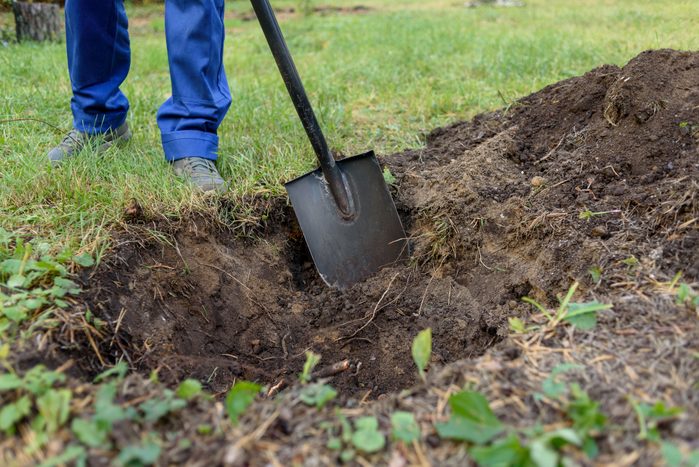
Before Digging a Hole
Important stretches: Shoulders, arms, neck and back.
Digging holes can be brutal on the body, but which part depends on the tool. A post-hole digger can cause a burn in the front of the shoulders, forearms and hands. A shovel can tire out a back in short order, because it requires bending. Legs are usually OK since most of the work is upper body.
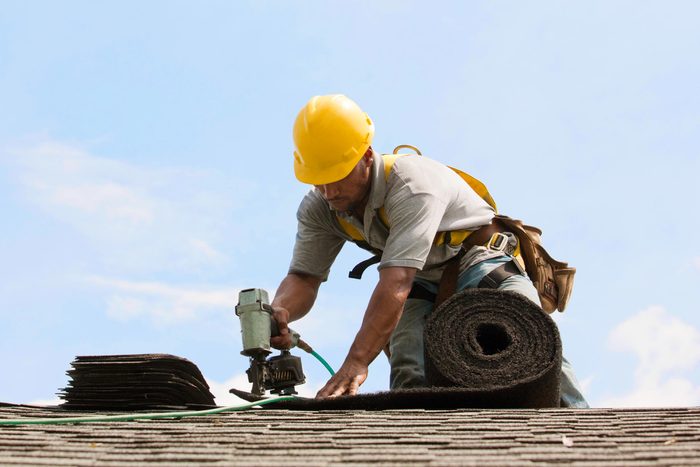
Before Working on a Roof
Important stretches: Legs and back.
Roofing is demanding work. If your back and legs are stiff, it can be painful and even dangerous. It’s important to stretch your back and legs, since much of the work involves bending over or propping your legs in uncomfortable positions for long periods.
Here’s another helpful stretch for roofing: Stand in front of a wall. With one leg straight and the heel on the ground, place the bottom of the foot on the wall. With the other leg, push the body forward to stretch the calf muscles and tendons. Hold for 10 seconds and repeat on the other side.
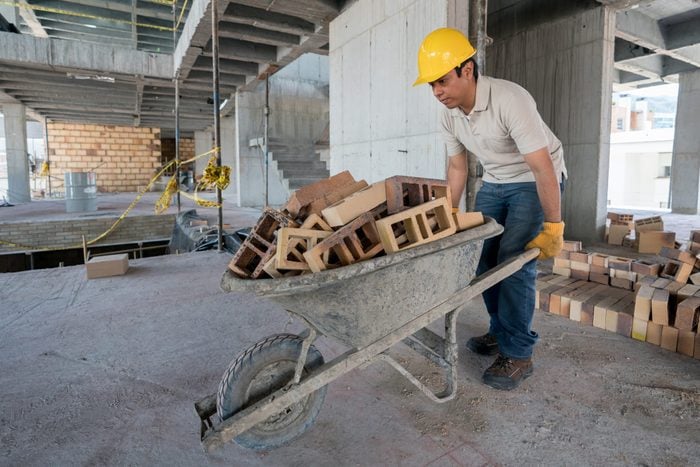
Before Using a Wheelbarrow
Important stretches: Back, core, shoulders and arm.
Wheelbarrows make moving heavy materials easier, but can be exceedingly heavy when fully loaded. The lower and upper back, core, shoulders and arms are always engaged to stabilize the wheelbarrow and prevent it tipping over.
To prepare for a day of pushing a wheelbarrow back and forth, focus on core and lower back stretches. These will keep you limber, stabilize the body and prevent injuries from stumbling, uneven loads or just repetition.
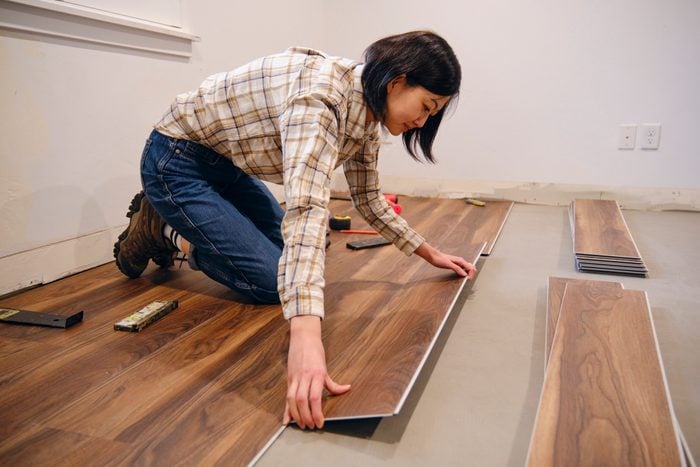
Before Putting in a Floor
Important stretches: Back, core and legs.
Working on hands and knees while laying a floor can be exhausting, particularly on the installer’s back. Whether it’s a tile floor or hardwood, the bending, reaching and twisting can fatigue your arms and core. For this type of work, a quick stretch focusing on the back, core and legs will help.
For extra insurance and mobility, consider a hip stretch. Start by kneeling on a cushioned object, then placing a foot in front of your body. Slowly lunge forward so the knee is over the foot, and then turn the upper body inward. Hold this for 30 seconds and repeat on the other side.
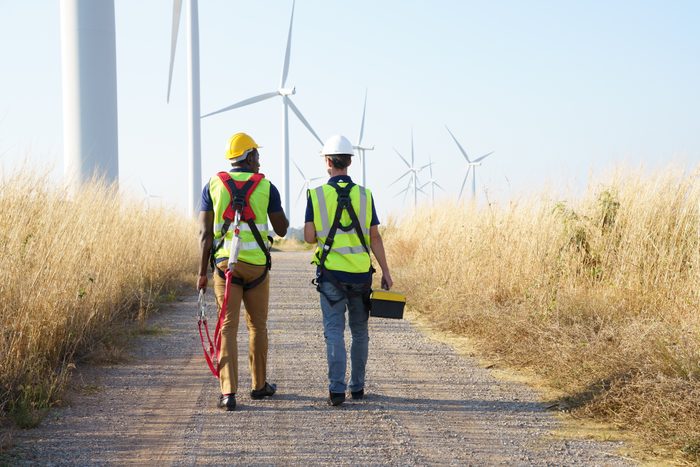
After Working a Full Day
Important stretches: All of them
Most folks would prefer to clock out and be done with their day, but a little preventative medicine can go a long way toward relieving tomorrow’s soreness. Be sure to give each area of the body a thorough stretch.
It’s also a good idea to ice any areas feeling particularly achy, just like a professional athlete might. Stretching and ice are great ways to decrease soreness and inflammation, helping the body recover and get back at it the next day.

